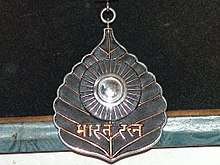M. G. Ramachandran
| M. G. Ramachandran HD | |
|---|---|
| எம். ஜி. ராமச்சந்திரன் | |
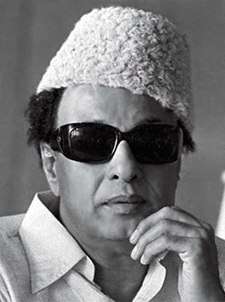 | |
| Chief Minister of Tamil Nadu | |
|
In office 9 June 1980 – 24 December 1987 | |
| Preceded by | President's rule |
| Succeeded by | V. R. Nedunchezhiyan (acting) |
|
In office 30 June 1977 – 17 February 1980 | |
| Preceded by | President's rule |
| Succeeded by | President's rule |
| Personal details | |
| Born |
Maruthur Gopalan Ramachandran 17 January 1917 Kandy, British Ceylon (present-day Sri Lanka) |
| Died |
24 December 1987 (aged 70) Madras, Tamil Nadu, India |
| Cause of death | Heart failure. |
| Resting place | MGR Memorial |
| Citizenship | Indian |
| Political party |
|
| Other political affiliations | Dravida Munnetra Kazhagam, Indian National Congress |
| Spouse(s) |
Thangamani (died in 1942) Sathanandavathi (died in 1962) V. N. Janaki (died in 1996) |
| Parents |
Gopala Menon (Father) Maruthur Sathyabama (Mother) |
| Relatives | M. G. Chakrapani (Brother) |
| Occupation |
|
| Awards |
|
Marudur Gopalan Ramachandran (17 January 1917 – 24 December 1987), popularly known as M. G. R., was an Indian actor, filmmaker and politician who served as the Chief Minister of Tamil Nadu for ten years between 1977 and 1987. He is a cultural icon in the state and is regarded as one of the most influential actors of the Tamil film industry.[1] He was popularly known as "Makkal Thilagam" (People's King) as he was popular with the masses.He was a philanthropist and a humanitarian icon.[2]
In his youth, Ramachandran and his elder brother M. G. Chakrapani became members of a drama troupe to support their family. Influenced by Gandhian ideals, MGR joined the Indian National Congress. After a few years of acting in plays, he made his film debut in the 1936 film Sathi Leelavathi in a supporting role. By the late 1940s, he graduated to lead roles and for the next three decades dominated the Tamil film industry. He became a member of the C. N. Annadurai-led Dravida Munnetra Kazhagam (DMK party) and rapidly rose through its ranks, using his enormous popularity as a film star to build a large political base. In 1972, three years after Annadurai's death, he left the DMK, then led by Karunanidhi, MGR's once friend and now rival, to form his own party—the All India Anna Dravida Munnetra Kazhagam (AIADMK). Five years later, he steered an AIADMK-led alliance to victory in the 1977 election, routing the DMK in the process. He became Chief Minister of Tamil Nadu, the first film actor to become a chief minister in India. Except for a six-month interregnum in 1980, when his government was overthrown by the Union government, he remained as chief minister till his death in 1987, leading the AIADMK to two more electoral triumphs in 1980 and 1984.
Ramachandran's autobiography Naan Yaen Piranthaen (Why I was Born) was published in 2003 in two volumes.[3]
Early life and background
M.G.R. was born in Kandy, Sri Lanka,[4] to a Malayali family of Melakkath Gopalan and Maruthur Satyabhama[5] from Palakkad, in the modern-day state of Kerala.[6]
In his early days, M.G.R. was a devout Hindu and a devotee of Lord Sri Murugan, and his mother's favourite god Lord Sri Guruvayurappan.[7] After joining the DMK, he turned a rationalist.[8]
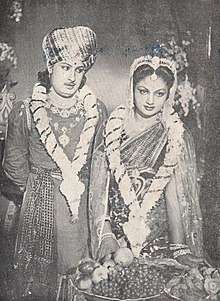
M.G.R's first marriage was to Chitarikulam Bargavi, also known as Thangamani, who died early due to an illness. He later married for the second time, to Satyanandavati, who also died soon after marriage due to tuberculosis.[9] In 1965, M.G.R. married for the third time, this time to V. N. Janaki a former Tamil film actress.[10] Janaki divorced her husband, Ganapathy, to marry M.G.R.
Acting career
Ramachandran made his film debut in 1936, in the film Sathi Leelavathi,[11] directed by Ellis Dungan, an American-born film director.[12] Generally starring in romance or action films, MGR got his big breakthrough in the 1950 film Manthiri Kumari, written by M. Karunanidhi. Soon he rose to popularity with the 1954 film Malaikkallan. He acted as hero in the Tamil film industry's first ever Gevacolor movie, the 1955 Alibabavum 40 Thirudargalum. He rose to become the heartthrob of millions of Tamilians with movies such as Thirudadhe, Enga Veettu Pillai, Aayirathil Oruvan, Anbe Vaa, Mahadevi, Panam Padaithavan, Ulagam Sutrum Vaalibhan, etc. He won the National Film Award for Best Actor for the film Rickshawkaran in 1972. He acted in many movies that appealed to the direct sentiments of the common man and the rich as well. His 1973 blockbuster Ulagam Sutrum Vaalibhan broke the previous box office records of his movies. It was one of the few movies filmed abroad in those days. It was shot in Singapore, Malaysia, Thailand, Hong Kong and Japan. The DMK tried very hard to illegally prevent the screening of the film using strong-arm tactics, but ultimately failed in its attempt. His acting career ended in 1987 with his last film Ullagam Suthi Paru, in which he acted even though he had been diagnosed with kidney failure.[13]
Mentor
Narayana Padaiyatchi Rathnam a pioneer of Tamil stage drama and K.P. Kesavan were chief mentors of Ramachandran in his acting career.[14]
Political career
MGR was a member of the Congress Party till 1953, and he used to wear khādī. In 1953 MGR joined the Dravida Munnetra Kazhagam (DMK) attracted by founder C.N. Annadurai. He became a vocal Tamil and Dravidian nationalist and prominent member of the DMK ("Dravida Munnetra Kazhagam" aka Dravidian Progressive Federation). He added glamour to the Dravidian movement which was sweeping Tamil Nadu. MGR became a member of the state Legislative Council in 1962. At the age of 50, he was first elected to the Tamil Nadu Legislative Assembly in 1967. After the death of his mentor, Annadurai, MGR became the treasurer of DMK in 1969 after Muthuvel Karunanidhi became the Chief Minister.
1968 Assassination attempt
The actor and politician M. R. Radha and MGR had worked in 25 films together. On 12 January 1967, Radha and a producer visited MGR to talk about a future film project. During the conversation, M. R. Radha stood up and shot MGR in his left ear twice and then tried to shoot himself.[15]
After the operation, MGR's voice changed. Since he had been shot in his ear, MGR lost hearing in his left ear and had ringing in the ear problems. These further surfaced in 1983 when he had kidney problems. When Sinnappa Devar paid his first visit to see MGR at the hospital after the shooting incident he paid MGR an advance for MGR's next movie. After getting released from the hospital and finishing Arasakattalai, MGR acted in Devar's movie Vivasaayee against doctors' advice. Due to the operation, MGR's speaking parts in the movie Kaavalkaaran were reduced. This was the only movie in which MGR spoke with old and new voices between scenes: MGR was acting in the film Kaavalkaran in 1967 opposite J. Jayalalithaa when the shooting occurred.
Petralthaan Pillaya was the last movie of MGR-MR Radha together. Shooting ended just few days before MGR was shot. The bullet was permanently lodged in his neck and his voice damaged. Within hours of the shooting, some 50,000 fans had gathered at the hospital where MGR had been taken. People cried in the streets. For six weeks, he lay in the hospital as fans awaited each report of his health. He was visited by a steady stream of commoners and luminaries of film industry, polity and bureaucracy. From his hospital bed, he conducted his campaign for the Madras Legislative Assembly. He won twice the number of votes polled by his Congress rival and the largest vote polled by any candidate for the Assembly.[16]
Split from DMK and formation of AIADMK
In 1972, DMK leader Karunanidhi started to project his first son M.K. Muthu in a big way in film and politics. Understanding the tactics played by Karunanidhi to corner him, MGR started to claim that corruption had grown in the party after the demise of Annadurai and in a public meeting asked for the financial details of the party to be publicized, which enraged the leadership of DMK. Consequently, MGR was expelled from the party as per Karunanidhi's plan.
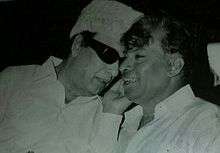
Upon his ouster from DMK, Ramachandran floated a new party which he called Anna Dravida Munnetra Kazhagam (ADMK), later renamed All India Anna Dravida Munnetra Kazhagam (AIADMK), the only powerful opponent of the DMK. He mobilized between 1972 and 1977 to spread and preach his party ambition with films like Netru Indru Naalai (1974), Idhayakani (1975), Indru Pol Endrum Vazhga (1977), etc.
Continued success in TN Assembly elections
1977 Assembly elections
The AIADMK contested the 1977 assembly elections in Tamil Nadu. The election was a four cornered contest between the ADMK, DMK, the Indian National Congress (INC) and the Janata Party. The ADMK allied itself with the Communist Party of India (Marxist), while INC(I) and Communist Party of India (CPI) contested as allies. The DMK and Janata Party (JNP) contested the elections alone. The ADMK did not field any candidate in the Usilampatti Constituency in support of the Forward Bloc leader P.K. Mookiah Thevar. Similarly, the ADMK also supported the Indian Union Muslim League (IUML) candidate M. Abdul Latheef in the Vaniyambadi Constituency. In the parliamentary elections that occurred just three months prior to these elections, there had been two major alliances – the ADMK led ADMK-INC-CPI coalition and the DMK led DMK-NCO-JNP-CPM coalition. But in the months that followed the parliamentary election, these coalitions fell apart. The AIADMK alliance won the elections by winning 144 seats out of 234 and MGR became the Chief Minister of Tamil Nadu. Upon winning the 1977 state elections, MG Ramachandran became the Chief Minister of Tamil Nadu on 30 June 1977, remaining in office till his death in 1987. In 1979, members of his party Satyavani Muthu and Aravinda Bala Pajanor became the first non-Congress politicians from Tamil Nadu to be ministers in the Union Cabinet. The AIADMK won every state assembly election as long as MGR was alive. Although Anna Durai and Karunanidhi had acted in stage plays in trivial roles, in their younger days, before becoming chief minister, MGR was the first popular film actor to be a Chief Minister in India.
1980 Parliament and assembly elections
Anna Dravida Munnetra Kazhagam allied with Indian National Congress (Indira) in the 1977 parliamentary election. However, when Janata Party won the election and Morarji Desai became the Prime Minister, M. G. Ramachandran extended unconditional support to the Janata party Government. He continued his support to the Charan Singh Government in 1979. After the fall of the Charan Singh government, fresh parliamentary elections were conducted in 1980. Dravida Munnetra Kazhagam struck alliance with INC(I). ADMK and Janata Party alliance won only 2 seats in Tamil Nadu in that parliamentary election. INC(I) won the election and Indira Gandhi became the Prime Minister. Congress-DMK victory in the 1980 parliamentary election emboldened their alliance and made them think that people lost their faith in M. G. Ramachandran government. DMK pressed the central government to dismiss the Tamil Nadu government using similar allegations used by MGR to dismiss DMK government in 1976. The ADMK ministry and the assembly were dismissed by the central government and fresh elections conducted in 1980. Despite their victory at the 1980 Lok Sabha polls, DMK and Indira Congress failed to win the legislative assembly election. ADMK won the election and its leader and incumbent Chief Minister, M. G. Ramachandran was sworn in as Chief Minister for the second time. He became the first leader since K. Kamaraj to win a re-election as Chief Minister.
1984 assembly elections
Indira Gandhi was assassinated on 31 October 1984. During the same time, M. G. Ramachandran was diagnosed with kidney failure and admitted into a hospital in New York City. Rajiv Gandhi assumed office immediately and this required a fresh mandate from the people. Indian National Congress (Indira) and Anna Dravida Munnetra Kazhagam formed an alliance and contested the election. M. G. Ramachandran was confined to the hospital. Video coverage of MGR recuperating in hospital along with Indira Gandhi's assassination were stitched together by the ADMK man in charge of campaigning, R. M. Veerappan. The video was distributed and played across all over Tamil Nadu. Rajiv Gandhi visited cyclone-hit areas in Tamil Nadu, which also boosted the alliance. The sympathy wave created by Indira's assassination, MGR's illness and Rajiv Gandhi's charisma helped the alliance sweep the election.[1][2] DMK leader M. Karunanidhi did not contest this election, due to the fact that the ADMK leader M.G.R was admitted to a hospital in the U.S. and Indira Gandhi being assassinated. It was a landslide victory for AIADMK-Congress combine which won 195 seats in assembly polls. The electoral victory proved the undying charisma of MGR upon the masses.
Achievements as Chief Minister of Tamil Nadu
Once he became Chief Minister of Tamil Nadu, he placed great emphasis on social development, especially education. One of his most successful policies was the conversion of the "Midday Meal Scheme", introduced by the popular Congress Chief Minister and kingmaker K Kamaraj, which already was encouraging underprivileged children to attend school, into "MGR's Nutritious Meal Scheme" in the government-run and -aided schools in Tamil Nadu by adding saththurundai – a nutritious sugary flour dumpling. This scheme was at a cost of Rs. 1 billion and was imposed in 1982. A little more than 120,000 children of the state were benefited. He also introduced Women's Special buses. He introduced a liquor ban in the state and preservation of old temples and historical monuments, ultimately increasing the state's tourist income. He set up a free school for the cinema technicians children in Kodambakkam called MGR Primary & Higher Secondary School which provided free mid-day meals in the 1950s. He led the ADMK to victory in the 1984 assembly elections, despite not taking part in the campaigning. At that time he was undergoing medical treatment in America and his images were broadcast in Tamil Nadu through cinema halls. This was an effective campaign tactic and ADMK won the elections claiming around 56% of assembly seats, indicating the depth of his popular support. He won his seat in a double landslide victory in 1984. He still holds the record of being the chief minister with the highest consistent longevity of more than a decade.
Karunanidhi claimed on 1 April 2009 and again on 13 May 2012 that MGR was ready for the merger of his party with the DMK in 1979, with Biju Patnaik acting as the mediator. The plan failed, because Panruti Ramachandran, who was close to MGR acted as a spoiler and MGR changed his mind.[17][18]
Criticism and controversies
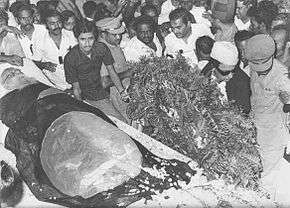
Even after his death, MGR proved to be very popular in the state and his rule has been cited by many of his contemporaries as best in the country.[19] However, his rule is not without criticism. Economic data under his rule showed that annual growth and per capita income was lower than the national average and the state went from being second among 25 industrialised states in development after Kamaraj's rule to tenth. This decline, according to critics has been due to shift of government resources from power and irrigation to social and agriculture sector according to Madras Institute of Development Studies reported in 1988. In addition, the emphasis on "welfare schemes" such as free electricity to farmers, mid-day meal schemes, etc. has been seen by many as taking money away from infrastructure development that could have benefited the poor. In addition, the liquor tax imposed during his rule was considered to contribute to a regressive tax mostly affecting the poor.
Other criticisms have been on MGR's centralised decision-making, which many blame for inefficiency and corruption taking hold of his administration. Some examples stated by the critics include Goondas act in 1982 and other acts that limited political criticism in the media, which led to a "police state" during his administration. While these criticisms have been in the minority, supporters of MGR counter that most of these problems were a result of the party members serving MGR rather than the leader himself. While he is not considered a divisive figure in the state, critics and supporters alike agree that his charisma and popularity trumped policy decisions that led to his eventual success during his tenure as chief minister.[20]
Natwar Singh in his autobiography One Life is Not Enough alleges that M.G. Ramachandra covertly supported the cause of independent Tamil Eelam and financed the LTTE and their cadres were being given military training in Tamil Nadu. He also alleges that M.G.R considered Jaffna an extension of Tamil Nadu and without informing the Indian Government at the time, had gifted 40 million rupees to the LTTE.[21]
MGR has been accused of being intolerant towards the media. In April 1987, the Editor of Ananda Vikatan S. Balasubramanian was sentenced to 3 months in jail by the Tamil Nadu Legislative Assembly for publishing a cartoon, depicting government ministers as bandits and lawmakers as pickpockets, though specific legislature was not specified. But due to media outcry, he was released and S. Balasubramanian later won a case against his arrest. Earlier, Vaniga Otrumai editor A.M. Paulraj was sentenced to 2 weeks imprisonment by the Tamil Nadu Legislative Assembly for his writing.[22][23]
Bharat Ratna

After his death in 1987, he became the second Chief Minister from the state of Tamil Nadu to receive the Bharat Ratna. The timing of the award was controversial, due to the fact that it was given so quickly after his death and he was elected as Chief Minister only 11 years before the award. Many opponents, mostly outside Tamil Nadu, criticised then ruling party INC, under Rajiv Gandhi to have influenced the selection committee to give the award to help win the upcoming 1989 Lok Sabha election. The ruling party forming a coalition with Jayalalithaa, the successor to MGR at that time, were able to sweep Tamil Nadu, winning 38 out of 39 seats, INC were however unable to win nationally.[24]
Commemorative Coins
To commemorate MGR's Birth centenary in 2017, the Ministry of Finance, Government of India decided to issue ₹100 and ₹5 coins that would bear his image as a portrait along with an inscription of "DR. M. G. Ramachandran Birth Centenary".[25]
Member of Legislative Assembly
| Year | Elected/Re-elected | Place | Party |
|---|---|---|---|
| 1967 | Elected | St. Thomas Mount | DMK |
| 1971 | Re-elected | St. Thomas Mount | DMK |
| 1977 | Elected | Aruppukottai | ADMK |
| 1980 | Elected | Madurai West | ADMK |
| 1984 | Elected | Andipatti | ADMK |
Chief minister
| Period | |
| 1977 - 1980 | Tamil Nadu state assembly election, 1977 |
| 1980 - 1984 | Tamil Nadu state assembly election, 1980 |
| 1984 - 1987 | Tamil Nadu state assembly election, 1984 |
Awards
- Filmfare Special Award - South for the film Enga Veettu Pillai[26]
- Filmfare Best Film Award for the film Adimai Penn[27]
- National Film Award for Best Actor for the film Rickshawkaran in 1971.
- Honorary doctorate received from University of Madras and The World University (Arizona) in 1974.
- Bharat Ratna was conferred by the Government of India (posthumously) in 1988 for his contribution in the field of Films and Politics.
- Tamil Nadu State Film Award for Best Actor for the film Kudiyirundha Koyil
- Tamil Nadu State Film Award for Best Film - First Prize in 1969
Philanthropy
He personally offered relief in disasters and calamities like fire, flood, drought, and cyclones. He was the first donor during the war with China in 1962 (Sino-Indian War), donating Rs. 75,000 to the war fund. He was the founder and editor of Thai weekly magazine and Anna daily newspaper in Tamil. He was the owner of Sathya Studios and Emgeeyar Pictures (willed to charity) which produced many of the films he acted in. He had gifted a golden sword weighing half a Kilogram to Mookambika temple in Kollur, Udupi district.[28]
Illness and death
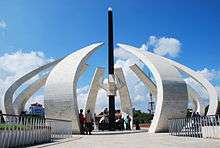
In October 1984, M. G. R. was diagnosed with kidney failure, which was further complicated by diabetes, a mild heart attack and a massive stroke. He was rushed to the Downstate Medical Center in New York City, United States for treatment, undergoing a kidney transplant. He returned to Chennai on 4 February 1985. He was sworn in as chief minister of Tamil Nadu for the third consecutive term on 10 February 1985. The next 2 years and 10 months were spent in frequent trips to the United States for treatment.
MGR never fully recovered from his illness and died on 24 December 1987 at 3:30 am in his Ramavaram Gardens residence in Manapakkam[29] after his prolonged illness. He was almost 71. His death sparked off a frenzy of looting and rioting all over the state. Shops, cinemas, buses and other public and private property became the target of violence let loose. The police had to resort issuing shoot-at-sight orders. Schools and colleges immediately announced the holidays till the situation came in control. The violence during the funeral alone left 29 people dead and 47 police personnel badly wounded.[30][31]
This state of affairs continued for almost a month across Tamil Nadu. Around one million[32] people followed his remains, around 30 followers committed suicide and people had their heads tonsured. After his death, his political party, the All India Anna Dravida Munnetra Kazhagam, split between his wife Janaki Ramachandran and J. Jayalalithaa; they merged in 1988.
In 1989 Dr. M. G. R. Home and Higher Secondary School for the Speech and Hearing Impaired[33] was established at the erstwhile residence MGR Gardens, Ramavaram, in accordance with his last will & testament written in January 1987. His official residence at 27, Arcot Street, T. Nagar is now M.G.R. Memorial House and is open for public viewing. His film studio, Sathya Studios, has been converted into a women's college.[34]
Filmography
As an actor
As producer and director
- 1958 Nadodi Mannan, producer and director
- 1969 Adimai Penn, producer
- 1973 Ulagam Sutrum Valiban, producer and director
- 1977 Madhuraiyai Meetta Sundharapandiyan, director
See also
References
- ↑ "India at 70 70 most influential Politicians of post-independence India".
- ↑ Sachi Sri Kantha (8 April 2015). "MGR Remembered – Part 26". Sangam.org. Retrieved 19 May 2017.
- ↑ "Janaki's son alone has copyright to MGR's autobiography: court". The Hindu. 4 July 2012. Retrieved 6 December 2016.
- ↑ Attar Chand (1988). M.G. Ramachandran, My Blood Brother. Gyan Publishing House. GGKEY:XEDQREZGYA6 Page 1.
- ↑ வள்ளல் பிறந்தார்..! || vallal born. Cinema.maalaimalar.com (19 February 2014). Retrieved 21 May 2014.
- ↑ Mani Shankar Aiyar (1 January 2009). A Time of Transition: Rajiv Gandhi to the 21 Century. Penguin Books India. pp. 38–. ISBN 978-0-670-08275-9.
- ↑ Linda Woodhead Religions in Modern World. Fletcher, Kawanam. p. 39
- ↑ M.S.S. Pandian (1992) The image trap. SAGE Publications. ISBN 0803994036. p. 131
- ↑ திருமணமும் தகுதி உயர்வும் || Marriage qualifying high. Cinema.maalaimalar.com (19 February 2014). Retrieved 21 May 2014.
- ↑ பொன்மனச் செம்மலின் வெற்றி வரலாறு (பகுதி 5): வி.என். ஜானகியை வாழ்க்கைத் துணைவியாக ஏற்றார்! || Mgr Cinema History. Cinema.maalaimalar.com (19 February 2014). Retrieved 21 May 2014.
- ↑ M. G. Ramachandran. bookrags.com
- ↑ Template:CHENNAIite news
- ↑ "MGR-Sivaji-Gemini: TRINITY Album Launched". IndiaGlitz. 22 January 2011. Retrieved 6 March 2012.
- ↑ "MGR Remembered – Part 4". Ilankai Tamil Sangam. 2013-02-02. Retrieved 2016-11-17.
- ↑ http://www.thehindu.com/news/cities/chennai/the-day-mr-radha-shot-mgr/article12059018.ece
- ↑ Selvaraj Velayutham (2008). Tamil cinema: the cultural politics of India's other film industry. New York: Routledge. ISBN 0-415-39680-8.
- ↑ "Tamil Nadu News : ADMK came close to merging with DMK: Karunanidhi". The Hindu. Chennai, India. 1 April 2009. Retrieved 3 January 2013.
- ↑ "Karuna recalls Biju's bid for DMK-ADMK merger". Zeenews.india.com. 13 May 2012. Retrieved 3 January 2013.
- ↑ "Polls show MGR as the best CM of Tamil Nadu". news.oneindia.in. 20 December 2006.
- ↑ Ingrid Widlund (1993). "A Vote for MGR Transaction and Devotion in South Indian Politics". Statsvetenskaplig tidskrifts. 96 (3): 225–257.
- ↑ K. Natwar-Singh (2014). One Life is Not Enough: An Autobiography. Rupa Publications India. ISBN 978-81-291-3274-1.
- ↑ "Arresting affair Arrest of Ananda Vikattin editor another press vs Ramachandran Government battle". S.H. Venkatramani. India Today. 30 April 1987. Retrieved 17 October 2015.
- ↑ "A trophy to remember". The Hindu. 16 November 2003. Retrieved 17 October 2015.
- ↑ Bharat Ratna- Isn't the arbitrary selection & politics making this highest civilian award controversy prone?. Merinews.com (20 November 2013). Retrieved 21 May 2014.
- ↑
- ↑ "புரட்சி நடிகர் எம்.ஜி.ஆர். அவர்கள் பெற்ற விருதுகள்| Lakshman Sruthi – 100% Manual Orchestra |". Lakshman Sruthi. 14 September 2007. Retrieved 13 May 2011.
- ↑ "M G Ramachandran, Times Exclusive Photo, Matinee idol M G Ramachandran". Timescontent.com. 1 April 1970. Retrieved 2 August 2011.
- ↑ "The Hindu : Karnataka News : Jayalalithaa offers prayers at Kollur temple". Hinduonnet.com. 31 July 2004. Retrieved 3 January 2013.
- ↑ "M.G. Ramachandrans death marks the passing of an era of stability in Tamil Nadu".
- ↑ "Popular Tamil Leader Dies in India;Rioting, Suicides Follow Death of Tamil Nadu's Chief Minister". Pqasb.pqarchiver.com. 25 December 1987. Retrieved 3 January 2013.
- ↑ "Tamil leader's death stirs India riots". Chicago Sun-Times. 26 December 1987.
- ↑ "Charlotte: Search Results". 26 December 1987.
- ↑ "MGR Home & Higher Secondary School for the Speech & Hearing Impaired". Mgrhome.in. Retrieved on 2015-04-18.
- ↑ ".:: Dr. MGR Janaki College of Arts and Science for Women, Chennai, Tamil Nadu, India ::.". Mgrjanaki.ac.in. Retrieved on 2015-04-18.
External links
| Wikimedia Commons has media related to M. G. Ramachandran. |
- M. G. Ramachandran on IMDb
- M.G. Ramchandran: Jewel of the Masses
- The Hindu – Politics and Suicides in TN
- All about Dr MGR
- MGR Memorial Charitable Trust
- MGR monthly magazine+News portal
- Kandy-born Actor-Politico "MGR" Reigned Supreme in Tamil Nadu Cinema and Politics-by D.B.S. Jeyaraj
| Political offices | ||
|---|---|---|
| Vacant Title last held by Karunanidhi |
Chief Minister of Tamil Nadu 1977–1987 |
Succeeded by Janaki Ramachandran |
